The Arms Supply
While agreement on both sides of the political fence doesn’t happen often; one thing the US legislative body does seem to hold a unified concord on, is Mexico’s drug problem. Not only does Mexico have a problem with the illegal trafficking of drugs over the US border, but the resulting war of rival gangs that have shocked the world with their violence are being conducted, in large part, with American arms. Alcohol, Firearms and Tobacco Control are pushing for stronger measures involving the sales of firearms. The US Justice Department has announced plans to cut arms trafficking into Mexico by monitoring the sale of assault rifles in border states.
There are a number of things wrong with, not only the solution, but the appraisal. Mexico doesn’t have a substantial drug problem. That is to say, the number of people imbibing anything more than distilled cactus juice, alcohol in general, marijuana or hallucinogenic mushrooms, is rather small. The US clientele is what has made the sales of cocaine, meth-amphetamines and opiates a lucrative trade. The US has a drug problem, and US clientele fuel the drug trade, finance the drug trade, but is not the reason for Mexico’s all out war.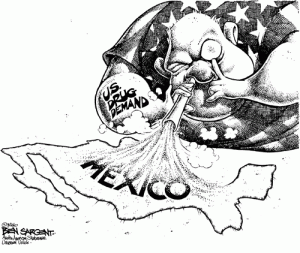
The American arms being used have been primarily provided by the US Government to the Mexican Government to conduct their war on drugs. How were the drug lords able to acquire these weapons? Is it possible they are so powerful, they were able to overcome Mexican Government forces and seize their weapons? If you have two rivaling factions, both expending manpower and gun power to maintain their position, how much is left for fighting a government whose military backing is funded by the US waged war on drugs? If looked at simply from the perspective of rivaling gangs, the solution to ending the blood feud does seem simple. Restrict border passage, erect a wall to prevent illegal immigration, and crack down on liberal gun laws in border towns.
The perspective is flawed. Logically, would two rivaling gangs be able to fight each other, the government, the US Drug Enforcement Agency, and the law abiding populace in a country of millions, without some serious back-up? These are not rivaling gangs, but organized crime, with its roots buried deeply into Mexican politics and Mexican enterprise.
Supporting an Unpopular President
In the year 2008, Condeleezza Rice visited Mexico to give a hand to President Felipe Calderon’s government in its efforts to reduce drug related crimes. Although the Bush administrated White House had already successfully pushed four hundred million dollars over the border for aid, Calderon declared this wasn’t enough. In the seceding years, despite the steady support of additional funds, the violence has only escalated, spreading beyond the central conflict around Mexico City and fanning like a wild fire into the border towns. While this all may seem puzzling to some, there is a logical reason. The US Government, as it did in Nicaragua, El Salvador and so many other places, was assisting an unpopular president.
While Condeleezza Rice looked around and decided Mexico had a drug problem, she did not take time to notice that Calderon had used US backed military deployment to invade Oaxaca City in 2006 and forcibly remove Mexico’s Revolutionary Party from office, jail or murder protestors, and cut off electrical use, water and food supplies. She had also failed to notice that Calderon had won the election by a narrow 51% and was publicly accused of using bribery and extortion to win his votes. The popular favorite was Lopez Obrador, a Socialist candidate and who is still referred to as Mexico’s “legitimate president”.
Obrador has some serious charges to take up with Calderon as well as a list of other powerful political figures he accuses of being Mexico’s Mafia. In a formal complaint filed with the Attorney General of the Republic of Mexico, he states:
“1 .- The group of criminals who denounced have been carrying out with impunity, acts that violate the Constitution and laws of the Republic. There is evidence that this is a dedicated conspiracy to influence peddling, corruption and looting of public assets and resources.
2 .- It is obvious that this mafia has not cared about the fate of the country, much less the welfare of the people. For over two decades, Mexico has been one of the countries with lower growth in the world (Annex 25 ECLAC report on economic growth in Mexico), since 1983 began to dismantle the policy of promoting and generating employment; is left without support to producers in the field, and deliberately neglected the energy sector to ruin and justify the privatization of electricity and the oil industry.
3 .- As a result of this policy of plunder, Mexico today is a country in ruins, whose extraordinary people have been sentenced to survival or to exile. Millions of families are suffering for lack of employment or because their income does not suffice even for the most essential. Many Mexicans are living in crowded conditions, abandoned, sick and without social security. Young people have been canceled their future, they do not have opportunities for work or studies, and have been forced to take the path of antisocial behaviors.
4 .- Also, these characters have taken over all, are primarily responsible for the insecurity and violence that is suffered in the country. Nothing good could be expected to happen when money replaced the social power and the government became a full committee at the service of a few.
5 .- This mafia is composed of Carlos Salinas de Gortari, Roberto Hernandez, Vicente Fox, Claudio X. Gonzalez, Felipe Calderon, Gaston Azcarraga, Elba Esther Gordillo, Diego Fernandez de Cevallos, Jose Luis Barraza and Ernesto Zedillo, among others.”
The Consequences of Corruption
Morale has been pretty low in Mexico lately. Over forty thousand drug related murders have occurred since President Calderon escalated his war on drugs. Only 30 percent of the Mexican voting public currently believes the country is headed down the right path, according to Consulta Mitofsky, Mexico’s most trustworthy pollsters. Ordinary Mexicans’ lack of confidence and distrust in the government and its officials is astounding, even for a typically cynical Latin American populace: In polls, politicians usually rank just below the police forces, which most Mexicans believe to be rampantly corrupt.
Their feelings about Obrador as the legitimate president are mixed. Some feel he sold out to the leading political parties, PRI and PAN to remain in an influential position as a delegate. Some feel he is an embarrassment to continue declaring himself Mexico’s true president without any formal documentation acknowledging his elective rights. With their own elections looming in the same year as the U.S., 2012, the parties are split by the same divisive factors splintering the US Democratic and Republican parties, with the same indifference as to who is at the helm.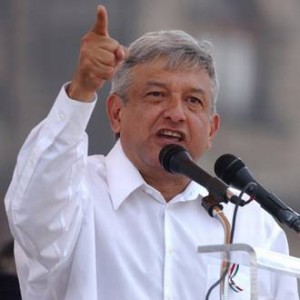
Corruption among law enforcement is great enough that one of the most brutal and powerful branches of the drug cartels is the Zeta’s. Originally meant to be a special operations, para-military unit in the late 1990’s, they received training from foreign specialists, including Americans, French, and Israelis. This military group, a Mexican equivalent to the Green Berets, was called the Gafes. Members of this elite unit, were trained in rapid deployment, aerial assaults, marksmanship, ambushes, intelligence collection, counter-surveillance techniques, prisoner rescues, sophisticated communications, and the art of intimidation. Their arsenal includes AR-15 and AK-47 assault rifles, MP5s submachine guns, 50-mm machine guns, grenade launchers, ground-to-air missiles, dynamite, bazookas, and helicopters.
Their journey from a special op military force to hit men for the drug lords seems to have been a short one. By the time Calderon took office in 2006, many of this elite force, enticed by higher pay than a government salary, had defected to join the other side. Unable to trust the police, already accused by the public of corruption, the President placed the army at the forefront of his war on drugs. The remaining Gafes, still loyal to the government, found themselves fighting the same people they had trained with, in the form of the Zetas.
It’s not possible to measure the number of people who have sided with or work for, the Zetas. Although the Army has detailed information about deserters, even key law enforcement agencies must guess at their size and composition because small-time criminals identify themselves as “Zetas” in hopes of exciting fear in their victims. For security purposes, Los Zetas have adopted a cell-like structure to limit the information that any one member of the organization knows about his associates.
Los Zetas have set up camps in which to train recruits aged 15 to 18 years old, as well as ex-federal, state, and local police officers. In addition, they have invited into their ranks ex-troops from Guatemala known as Kaibiles. Reviled as “killing machines,” these tough-as-nails experts in jungle warfare and counterinsurgency adhere to the motto: “If I advance, follow me. If I stop, urge me on. If I retreat, kill me.”
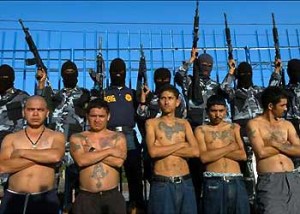 The United States has sent funds, arms and military training into a country run by an unpopular president. The President of this country has turned these funds and weapons over to a military that has partially defected and a police force nobody trusts. Many of these weapons have turned up in the aftermath of violent attacks, formally declared as feuds between rivaling drug gangs. These gangs flourish through the sales of drugs to an American clientele. They also flourish because their country is poverty stricken and desperate.
The United States has sent funds, arms and military training into a country run by an unpopular president. The President of this country has turned these funds and weapons over to a military that has partially defected and a police force nobody trusts. Many of these weapons have turned up in the aftermath of violent attacks, formally declared as feuds between rivaling drug gangs. These gangs flourish through the sales of drugs to an American clientele. They also flourish because their country is poverty stricken and desperate.
While the war on drugs has already cost tax payers an enormous amount of money on both sides of the border, and taken the lives of innocent men, women and children, it has become a handy tool for a US Government that never has been very good at accepting responsibility for its mistakes and poor judgment. Gun rights activists are angry at the Supreme Court decision to monitor firearm sales in the border states as they feel it’s a way of circumventing the Second Amendment right to bear arms without a Congressional vote. Proponents for stricter immigration laws need only point to the violence in Mexico as a good reason for such harsh measures.
For those caught up in the cross-fire, there is no light at the end of the tunnel, no hope in sight, no solution to the rabid machinery that has destroyed their homes, their livelihood and their families. Only one thing has become clear in this fiasco to promote law-making special interests: You cannot hire the corrupt to end corruption.
http://articles.cnn.com/2011-06-14/us/mexico.guns_1_mexican-drug-drug-cartels-drug-gangs?_s=PM:US
http://www.nytimes.com/2008/10/23/world/americas/23rice.html
http://interamericansecuritywatch.com/can-mexico-fix-its-image-problem/
http://www.fpri.org/enotes/200805.grayson.loszetas.html

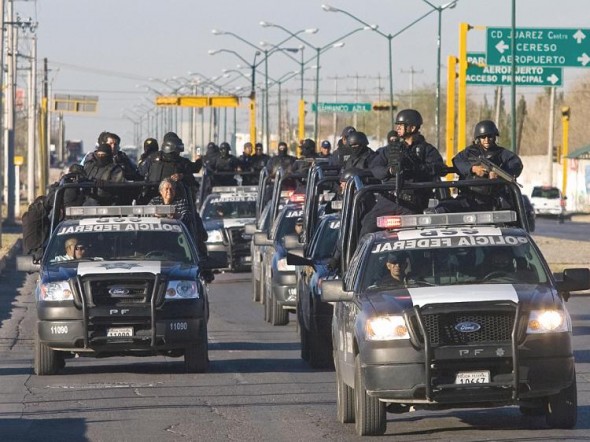
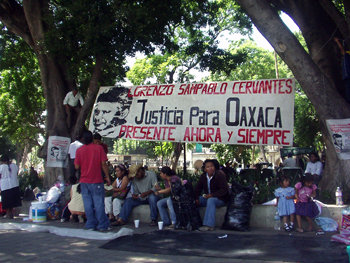
Great researching there, Karla. It’s a very clear stance on a complicated subject, and you made a lot of good points. Look forward to hearing more on this.
Thank you, Mitch. By the time i had finished researching for the article, i was feeling a bit deflated. Most civil violence is the result of revolution, but this is a revolution that got aborted in its infancy through temptation. Once the rug had been pulled completely from out under the economy, and all ethics erased, it was all about who could make the most money and how to keep it.
I think the United States is following very closely in its steps. The economy is growing worse. Unemployment is rampant. Ethics are dissolving rapidly. Nobody trusts the governing body. Anyone who finds a way of making money is going to be desperate to protect it. I would not be surprised to see the days of organized crime return to the United States with Godfather-like viciousness. In fact, i wouldn’t be at all surprised to discover those days are already here.
[Quote=Article]. Their arsenal includes AR-15 and AK-47 assault rifles, MP5s submachine guns, 50-mm machine guns…[/quote]
Whoa, stop right there – 50mm machine guns? That’s not a machine gun, that’s a damn cannon: the only place you’ll find a weapon like that is attached to “tank-killer” aircraft (think AC-130 gunships or A-10 Warthogs) or some medium/heavy armor assualt vehicle (like the M1A1 battle tank or M2 Bradley Infantry Fighting Vehicle). I believe you meant to say “.50 caliber machine guns” – which are only 12.7mm in diameter.
All that said, it’s not the firearms that are the problem (guns are just tools, you know) – it’s the fact that the state *wants* a perpetual “war or drugs” so that it might control the drug trade for its own benefit! I’ve known a few people who have come back from the side and they’ve told me all sorts of shit that conflicts with the official narrative: for example, seletive burning of marajuana fields and “convenient” arrests and assassinations that allowed informers to rise within a cartel – not to mention rumors of “black budgets” from the drug operations themselves going to agencies like the CIA, M-16 and Mossad (of course, these are just rumors – there’s no way to actually confirm these reports with the “national security” classifications attached to any information that information that might shed light on the subject…).
Azazel, i quoted the type of artillery discovered directly from one of the websites listed, so they are either publishing faulty information or there is a serious hemorrhage among Mexican police and army defectors. There were many things i would have liked to have said about this so called drug war, but was reluctant to express my thoughts without supporting evidence. As you said, it’s simply a lucrative business. Whenever a business is profitable; especially one that can be laundered; there are a lot of fingers delving into the pie. If you are already corrupted, it doesn’t take much to justify a drug war.
Yeah, the 50mm machine gun your source quoted must have been a typo (as there is no such machine gun classification – anything up in caliber from the .50 is considered a cannon) – however, it would not shock me to hear that some cartels might have gotten their hands on some old anti-aircraft artillery guns of comparable size (such as this one – http://en.wikipedia.org/wiki/Bofors_40_mm ).
However, like I said, the guns are not the probelm – it’s the powers that perpetuate the war…
Actually, if they are holding an old anti-aircraft artillery gun like that, it would put at least part of this “war” in a different light. The photo of the Bofor looks much like the anti-aircraft weaponry used by Nicaragua and El Salvador when they decided to over-turn the ruling class. The weapon of choice for the El Salvador revolutionary leader, by the way, was a .22 sniper rifle. It just goes to show how far determination can get you.
Well, plenty of weaponry is damaged, destroyed or “misplaced” in times of conflict – it would not surprise me at all if some of the weapons from the conflicts you mentioned were recovered, repaired and sent to the “black markets” where the cartels picked them up. These pieces are old, but can still be useful for taking out low-flying aircraft or choppers that get too close to cartel operations…
Good article Karla. There is so much to think about in this volatile situation in Mexico. We worry so much about the Middle East and yet our neighbors, friend and trade partners are living in THE most violent situation in the world.
Contributing to this on our side, the Federal Assault Weapons Ban (AWB) on our side of the border timed out in 2004, Then President Bush decided not to reinstate it and neither has our sitting President Obama. Interesting.
Without making comment on the usefulness or goodness or badness of weapons, it does make one wonder if the hope was to let gangs on both sides of the border kill themselves off. If that is the case it is clearly not working.
Long time reporters in Mexico like Jorge G. Castaneda report that since the end of the AWB more of America’s Automatic weapons have been showing up in Mexico frequently at scenes of massacres.
It’s something to think about, keeping an eye on where our guns go.
@ grainnerhuad,
Doubtful – the U.S. government *needs* the drug war to continue and if the gangs kill each other off the result will be one cartel to rule them all (which would go against the interests of the police state – they need an excuse to keep militarizing the police force). The U.S. wants the violence to go on, thus it wants there to be as many competing gangs fighting for territory and profits as posible: the larger the turf wars, the more justification there is to bolster the state’s police powers.
Regarding the guns, it’s my opinion that everyone should have at least one and none of them are to be registered – this way the “law” enforcement establishment has no idea who has what weapons at their disposal (making them think twice before breaking down some fellow’s door – will he be unarmed and defenseless, or will he have multiple mil-spec weapons pointed at the heads of the intruders? Will the state paramilitaries be willing to risk their lives to find out? Doubtful…).
@Azazel I agree with you on the ownership of guns, in fact it’s why I didn’t want to comment on the “goodness or badness” of them. It is ridiculous the amount of paperwork and “classes” as I just learned one typically has to go through to transfer a gun from one private owner to another. However there is something there in the fact that the gangland war in Mexico is being ampted up by guns made and registered in the U.S.
There are a lot of things that simply don’t add up in this so-called gangland warfare. Azazel, i agree that the US wants the drug war to continue. It gives them an excuse to send military aid into Mexico, to lock down the borders and create discriminatory immigration laws. But i don’t believe it’s so the gangs can just kill each other off. Mexicans are smarter than that. If they are caught up in a war, it’s for a far deeper reason than the desire for an Al Capone life style.
As you pointed out earlier, there is selective burning of marijuana fields and “convenient” arrests and assassinations that allow informers to rise within a cartel. An informer can not possibly rise in a cartel unless the cartel is government sanctioned. No self-respecting lawless member is going to accept a snitch into his cartel no matter how beneficial the information was, as a snitch can’t be trusted among the lawless. Only the adherents to legal documents would consider a snitch an asset. Since the cultivation of marijuana is illegal, there can be no selective burning without a government pay-off.
Here’s where it begins to become very complex, as marijuana operations in Mexico are not the same as in the United States, where the growers get rich, keep hired guns and maintain a low, mafioso type profile. In Mexico, the growers are usually poor Indian villages with two choices for their livelihood; grow corn, and receive enough of a wage to barely scrap two meals together of tortillas, beans and rice, or grow marijuana, which will buy you new clothes, a radio, chickens, goats and for the most successful; horses.
Most of my years in Mexico were spent south of Mexico City, where violence was always rumbling on the horizon. The drug trade was virulent, but the scenario would usually go something like this: First the federales would invade the villages, removing from the homes anything a corn farmer could not possibly afford; appliances, nice furniture, extra livestock, jewelry. They would then beat the young men in an effort to make them give up their fields. Sometimes, they would take a few of the young men out to the woods and kill them. This made both the villagers and the buyers angry. The villagers would tell the buyers which federales were involved, the buyers would supply the villagers with guns, and they would all go out and shoot a few federales. In retaliation, the federales would return and shoot some more villagers, which only served to create a few more grisly feats.
Throughout it all, however, you never heard the villagers or the buyers say they were taking part in gangland drug feuds. You never heard of one village going to war with another. There were no incidences of buyers killing buyers. What you did hear was that they were fighting in a revolution that consisted of nothing more than the right to potable water, good jobs, adequate shelters and enough food.
Grainne, i never spent much time in the border areas, so i couldn’t tell you exactly what is going on there, but what i suspect is that in aborting a revolution by calling it a drug war, the shock wave has put the American gangland style of warfare at Mexico’s front door. Stripped of any legitimate voice for their protests against poverty, it has become a treacherous process of choosing sides, with no security that the side you’re on will protect you.
WHO IS THE AUTHOR?
@ ana the author to this article is listed at the beginning and is Karla Fetrow.
[…] If anyone has any illusions as to the depth of violence our addictions to drugs has echoed to in Mexico they should take a gander at such documentories as Drug Wars: Silver or Lead (Plato o Plomo) as well as Plan Colombia: Cashing in on the Drug War Failure better take a slow read of U.S. Contributions to Mexico’s War on Drugs […]